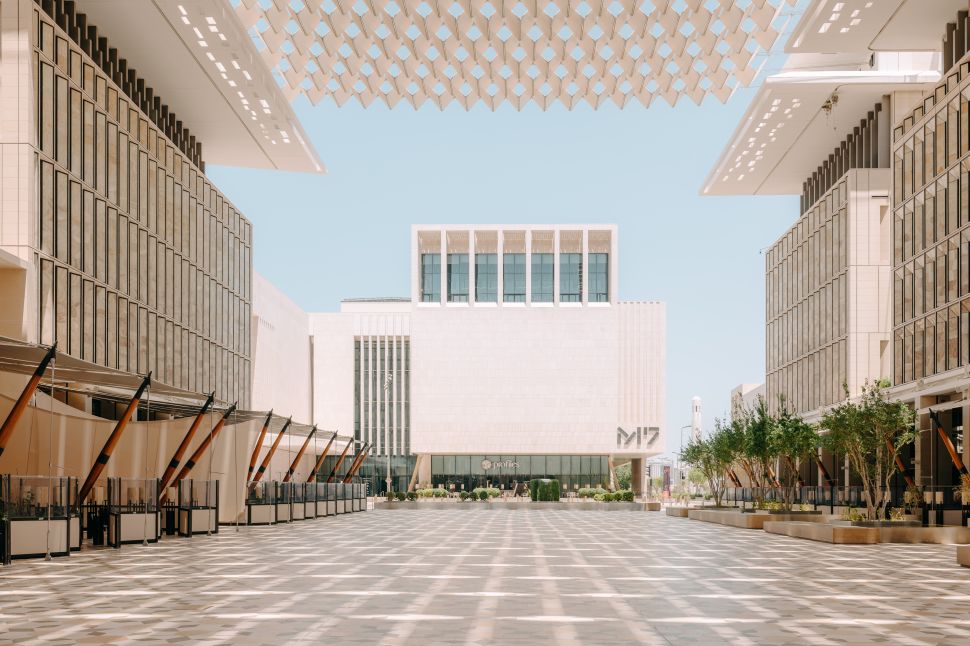Although there had been rumors that Art Basel was in talks with Abu Dhabi Art to launch an edition in the fast-growing region, the fair will instead land in Doha, with the new Art Basel Qatar set to open in February 2026. The initiative was born out of a partnership between Art Basel parent company MCH Group, creative collective QC+ and Qatar Sports Investments (QSI), one of the country’s leading cultural organizations.
Conceived as a boutique fair, the inaugural edition of Art Basel Qatar will feature a curated roster of approximately fifty galleries, making it significantly smaller than Art Basel’s other editions—at least for now. It will take place at the M7 creative hub and the Doha Design District in downtown Msheireb, near recently established cultural landmarks like the National Museum of Qatar.
The move aligns with the country’s broader efforts to diversify its once oil-centered economy and position itself as a global cultural and tourism hub. Like neighboring states such as the UAE and Saudi Arabia, Qatar is investing heavily in museums, cultural initiatives and large events spanning the arts and sports sectors. “As part of His Highness the Amir’s National Vision 2030, Qatar has been transforming itself into a knowledge-based economy, with culture and the creative industries helping to lead the way,” said Sheikha Al Mayassa bint Hamad bin Khalifa Al Thani, Chairperson of Qatar Museums, in a statement, adding that strong cultural and athletic ecosystems can “break down barriers, create shared experiences, increase understanding and drive positive change.”
SEE ALSO: Phillips Installs Robert Manley and Miety Heiden in Top Posts Amid Market Shifts
Qatar previously hosted the World Cup in 2022 and has plans to open three museums by 2030, including the Art Mill Museum and the Lusail Museum (in addition to five other newly opened museums). New creative and cultural hubs have also launched in Doha, including the Fire Station: Artist in Residence, M7 and Liwan Design Studios and Labs, as well as the 3-2-1 Qatar Olympic and Sports Museum. A few months ago, Qatar announced a new national pavilion in the Venice Biennale, the first permanent national pavilion built inside the Venice Giardini since South Korea opened its pavilion in 1995. The Sheikha, who was on Observer’s 2024 list of the most influential people in art, will oversee Qatar’s biennale presentations.
Nasser Al-Khelaïfi, chairman of QSI, described Art Basel’s arrival as a cultural sequel to Qatar’s hosting the World Cup, pointing to the country’s strategy of integrating sports and culture as dual engines of global soft power. “As that event demonstrated so unforgettably, sports and culture are closely linked in their capacity to unite people and bring the world together,” he said in a statement.
Art Basel Qatar promises to give international galleries meaningful access to the dynamic MENA region. The collaboration with institutions like QSI and QC+—both instrumental in shaping Qatar’s cultural infrastructure—will help the fair reach the right audiences across Doha and the broader Gulf. “Qatar’s depth of collections, history of building great cultural institutions and unique role as an incubator and supporter of talent position the new Art Basel Qatar for success on the world stage,” CEO Noah Horowitz said in a statement. Andrea Zappia, chairman and CEO of MCH Group, added that following the successful launch of Art Basel Paris, the organization is now ready to introduce a fifth fair to its growing global portfolio.
For Vincenzo de Bellis, director of fairs and exhibition platforms for Art Basel, the initiative will open the door to new possibilities for the organization’s existing shows in Basel, Miami Beach, Hong Kong and Paris. “This new edition in Qatar will broaden connections and horizons for our galleries and partners, amplifying artistic dialogues and further extending the global reach of Art Basel’s ecosystem,” he told Observer, affirming that the launch of Art Basel Qatar marks a long-term commitment to spotlighting diverse regional perspectives and investing in both art education and market development.
For now, the leading regional art fairs remain Art Dubai—held in late March—and Abu Dhabi Art, scheduled for January. However, both have faced notable declines in participation from blue-chip galleries and established international dealers, particularly in the aftermath of the pandemic. At the most recent Art Dubai, only a handful of returning international dealers took part, including Perrotin, Almine Rech, Peres Projects, Galleria Continua, Waddington Custot and Bortolami—most of whom had been absent during the pandemic. Among them, Perrotin remains one of the few global blue-chip galleries with a permanent space in the region, a sign of the long-term investment needed to build lasting engagement.
Meanwhile, several established Dubai-based galleries—such as Carbon 12, The Third Line and Leila Heller Gallery—are now appearing regularly on the international circuit, but the region still lacks the broad ecosystem necessary to support sustained global visibility.
Art Basel’s arrival may shift this dynamic, offering a more robust platform to connect the international art world with the Gulf while accelerating the development of the region’s own scene—not only by boosting the visibility of Qatar’s already branded institutions but also by drawing attention to emerging galleries, artists and residency programs. It’s a role the fair has played before: in Hong Kong, it helped catalyze the city’s transformation into a cultural hub within a decade of its launch. “Growing the global art market, supporting artists and galleries and developing new collecting audiences is core to Art Basel’s mission,” said Horowitz. “The art scene across the MENA region has undergone exponential growth in recent decades, with the establishment of world-class institutions, the launch of leading cultural events and the growth of a vibrant community of artists, galleries and professionals.”

